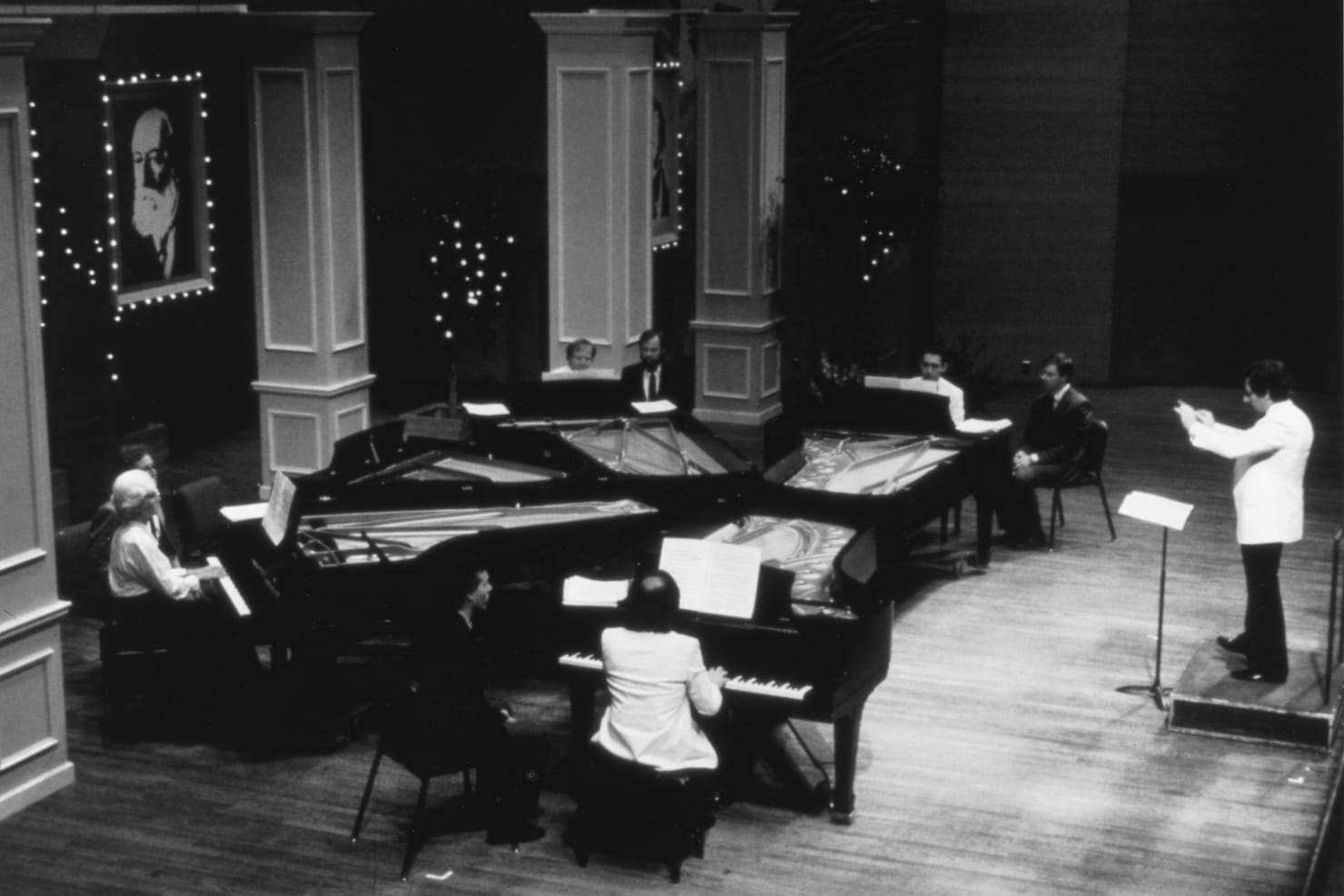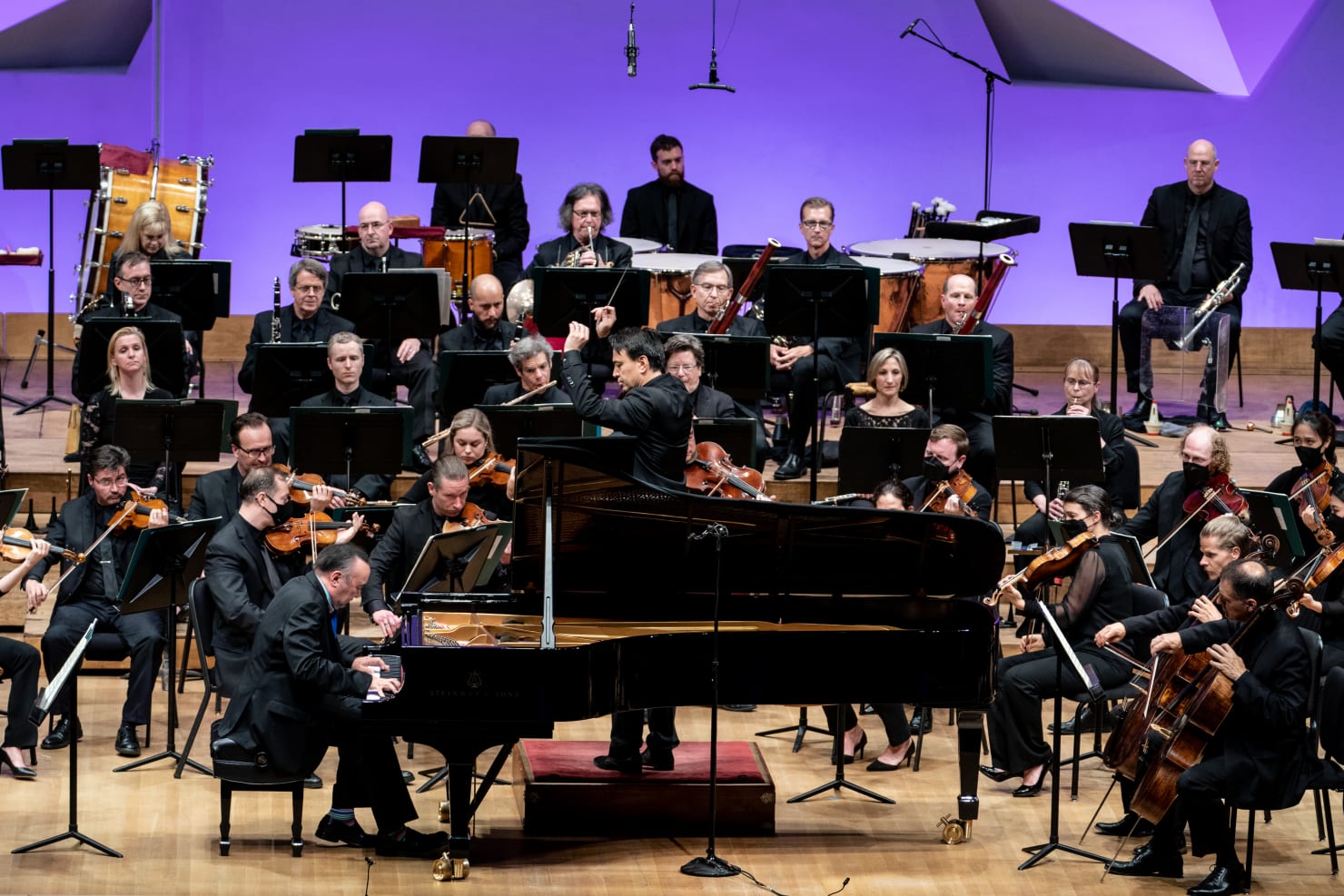Key Contributors: Pianists in Minnesota Orchestra History

The appearance on February 3 and 4 by Venezuelan-born pianist Gabriela Montero, who performs her own Latin Piano Concerto with the Minnesota Orchestra under conductor Carlos Miguel Prieto, is the newest chapter in the Orchestra’s long history of featuring renowned piano soloists.
The piano, a relatively late arrival in the history of Western acoustic musical instruments, is not part of most pre-20th century orchestral works except, of course, for piano concertos—which have become a beloved genre. One reason for piano concertos’ popularity is the instrument’s versatility, its 88 keys offering an unparalleled range of pitches with a sound that can easily fill a large concert hall. In addition, many listeners have a personal connection with the instrument from piano studies of their youth. The piano’s populist appeal is evident locally in the Pianos on Parade program that places custom-painted pianos throughout downtown Minneapolis for the public to play each June.
During its 120-year history, the Minnesota Orchestra has performed with hundreds of accomplished pianists, including famous talents such as Martha Argerich, Emanuel Ax, Alfred Brendel, Van Cliburn, Glenn Gould, Dame Myra Hess, Vladimir Horowitz, Barbara Nissman, Garrick Ohlsson and Sergei Rachmaninoff. Several members of the Orchestra’s conducting ranks, including Dimitri Mitropoulos, Sarah Hicks and Andrew Litton, have also taken turns at the keyboard.
Pianists through the years
On December 1, 1903, Harold Bauer became the first piano soloist ever to perform with the Minnesota Orchestra, then known as the Minneapolis Symphony Orchestra. Appearing in the Orchestra’s second-ever concert, the English-born pianist performed Camille Saint-Saëns’ Second Piano Concerto. The following month, German composer-pianist Adele aus der Ohe became the first woman to perform as a piano soloist with the Orchestra—as well as the first soloist to play an original composition at an Orchestra concert, her Eine Sage (A Legend).
Groundbreaking American composer-pianist Amy Beach made her sole appearance with the Orchestra on December 14, 1917, when Emil Oberhoffer conducted her Gaelic Symphony and Beach took the stage as soloist in her Piano Concerto. The composer-pianist was billed in the program as “Mrs. H. H. A. Beach,” the name she used professionally in reference to her husband Henry H. A. Beach, following the convention of the time in which some married women were referred to by their husband’s name. Beach’s music, which has enjoyed a resurgence in recent years, was not performed again by the Minnesota Orchestra for more than a century, a period in which entire seasons sometimes went by without the programming of works composed by a woman. Her Gaelic Symphony was the centerpiece of an Inside the Classics concert in April 2019.

Minneapolis native Eunice Norton was the first piano soloist to be featured on a Minnesota Orchestra recording. On January 15, 1935, she was the soloist in a recording of Arthur Honegger’s Concertino for Piano and Orchestra, with Eugene Ormandy conducting, released on the RCA Victor label. Norton’s performance found a new life decades later when the Honegger work was included in the Orchestra’s Centennial CD set in 2003.
On November 16, 1946, the Orchestra recorded Peter Ilyich Tchaikovsky’s First Piano Concerto with famed pianist Arthur Rubinstein—a session that got off to a poor start after Rubinstein encountered difficulty hailing a taxi from his hotel to the recording site, Northrop Auditorium, before finally sharing a cab with fans headed to that day’s University of Minnesota vs. Iowa football game. Furthermore, noise from airplane traffic above the nearby football stadium was spoiling the Orchestra’s recording. A special call was made to the airport and air traffic was rerouted. (Hometown sports fans went home happy as well, as the Gophers won the game 16-6.)

André Watts captured international attention in January 1963 when, at age 17, he made his New York Philharmonic debut, subbing for an ill Glenn Gould in a performance of Franz Liszt’s First Piano Concerto conducted by Leonard Bernstein. A year later, on January 31, 1964, Watts made his first appearance with the Minnesota Orchestra, playing the same Liszt concerto under Vladimir Golschmann’s direction. Watts has since enjoyed one of the longest-running relationships between the Minnesota Orchestra and a piano soloist, appearing most recently in a July 2017 concert with Andrew Litton conducting.

Among the more audacious concepts in the early years of the Minnesota Orchestra’s Sommerfest, which was founded in 1980, were the Grand Piano Extravaganzas masterminded by then-Sommerfest Artistic Director Leonard Slatkin, who is a pianist himself. Featuring as many as ten pianos onstage at once, the concerts will long be remembered by audiences and stagehands alike.
This tradition was revived in summer 2022 when renowned pianist Jon Kimura Parker, the creative partner for the Orchestra’s summer season—now called Summer at Orchestra Hall—performed a Grand Piano Spectacular with fellow pianists Scott Cuellar, William Eddins and Andrew Staupe. Piano played a prominent role at the entire 2022 Summer at Orchestra Hall festival, as Parker was featured as soloist several times. He will be at the helm of the festival the next several summers, ensuring that future piano fireworks will be in store.
During Osmo Vänskä’s tenure as Minnesota Orchestra music director, the Orchestra has made acclaimed recordings with two pianists: Stephen Hough and Yevgeny Sudbin. With Hough, the Orchestra made a live-in-concert recording of Tchaikovsky’s three piano concertos and Concert Fantasia over a series of four concerts in 2009 for the Hyperion label. Sudbin’s recordings of Beethoven’s Piano Concertos No. 3, 4 and 5, plus Mozart’s Piano Concerto No. 24, spanned the years 2009 to 2012 and were released on the BIS Records label.

Pianists from or living in Minnesota play a vital role in numerous Minnesota Orchestra concerts in solo, chamber or ensemble roles. Conductor-pianist William Eddins, who served as the Orchestra’s assistant and associate conductor for five seasons in the 1990s, has appeared at Orchestra Hall in several capacities during recent seasons, including as a conductor, pianist and frequent host of the This Is Minnesota Orchestra broadcast and livestream series. University of Minnesota Professor Emerita Lydia Artymiw and her former student Andrew Staupe, a native of St. Paul, have each performed several concertos with the Orchestra, including joint performances of Mozart’s Double Piano Concerto in January 2011. Local pianists who perform often with the Orchestra in chamber or ensemble roles include Susan Billmeyer—who was prominently featured in a Sommerfest 2019 program centered around Clara Schumann—Tommy Barbarella, Dean Billmeyer, Mary Jo Gothmann, Mary Louise Knutson, Timothy Lovelace, Bryan Nichols, Gail Olszewski and Casey Rafn.

For the next chapter in the Minnesota Orchestra’s history with pianists, join us at Orchestra Hall on February 3 and 4, as Gabriela Montero performs her own Latin Piano Concerto in concerts led by Carlos Miguel Prieto that also feature Maurice Ravel’s Rapsodie espagnole, Carlos Chávez’s Symphony No. 2, Sinfonía India, and Manuel de Falla’s Suite from The Three-Cornered Hat. The concert on Friday, February 3, at 8 p.m. Central, will also be broadcast live on Twin Cities PBS (TPT-2) and YourClassical Minnesota Public Radio, and will be available for live streaming via the Orchestra’s website and social media channels.






